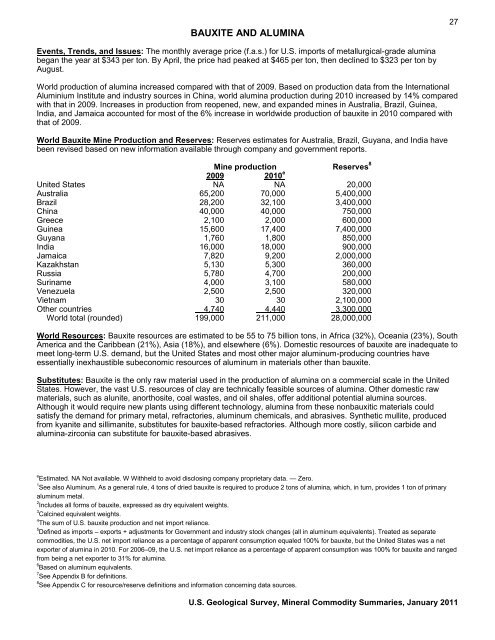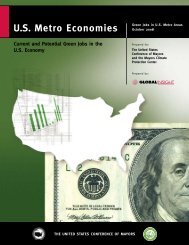BAUXITE AND ALUMINA27Events, Trends, <strong>and</strong> Issues: The monthly average price (f.a.s.) for U.S. imports of metallurgical-grade aluminabegan the year at $343 per ton. By April, the price had peaked at $465 per ton, then declined to $323 per ton byAugust.World production of alumina increased compared with that of 2009. Based on production data from the InternationalAluminium Institute <strong>and</strong> industry sources in China, world alumina production during 2010 increased by 14% comparedwith that in 2009. Increases in production from reopened, new, <strong>and</strong> exp<strong>and</strong>ed mines in Australia, Brazil, Guinea,India, <strong>and</strong> Jamaica accounted for most of the 6% increase in worldwide production of bauxite in 2010 compared withthat of 2009.World Bauxite Mine Production <strong>and</strong> Reserves: Reserves estimates for Australia, Brazil, Guyana, <strong>and</strong> India havebeen revised based on new information available through company <strong>and</strong> government reports.Mine production Reserves 82009 2010 eUnited States NA NA 20,000Australia 65,200 70,000 5,400,000Brazil 28,200 32,100 3,400,000China 40,000 40,000 750,000Greece 2,100 2,000 600,000Guinea 15,600 17,400 7,400,000Guyana 1,760 1,800 850,000India 16,000 18,000 900,000Jamaica 7,820 9,200 2,000,000Kazakhstan 5,130 5,300 360,000Russia 5,780 4,700 200,000Suriname 4,000 3,100 580,000Venezuela 2,500 2,500 320,000Vietnam 30 30 2,100,000Other countries 4,740 4,4403,300,000World total (rounded) 199,000 211,000 28,000,000World Resources: Bauxite resources are estimated to be 55 to 75 billion tons, in Africa (32%), Oceania (23%), SouthAmerica <strong>and</strong> the Caribbean (21%), Asia (18%), <strong>and</strong> elsewhere (6%). Domestic resources of bauxite are inadequate tomeet long-term U.S. dem<strong>and</strong>, but the United States <strong>and</strong> most other major aluminum-producing countries haveessentially inexhaustible subeconomic resources of aluminum in materials other than bauxite.Substitutes: Bauxite is the only raw material used in the production of alumina on a commercial scale in the UnitedStates. However, the vast U.S. resources of clay are technically feasible sources of alumina. Other domestic rawmaterials, such as alunite, anorthosite, coal wastes, <strong>and</strong> oil shales, offer additional potential alumina sources.Although it would require new plants using different technology, alumina from these nonbauxitic materials couldsatisfy the dem<strong>and</strong> for primary metal, refractories, aluminum chemicals, <strong>and</strong> abrasives. Synthetic mullite, producedfrom kyanite <strong>and</strong> sillimanite, substitutes for bauxite-based refractories. Although more costly, silicon carbide <strong>and</strong>alumina-zirconia can substitute for bauxite-based abrasives.e Estimated. NA Not available. W Withheld to avoid disclosing company proprietary data. — Zero.1 See also Aluminum. As a general rule, 4 tons of dried bauxite is required to produce 2 tons of alumina, which, in turn, provides 1 ton of primaryaluminum metal.2 Includes all forms of bauxite, expressed as dry equivalent weights.3 Calcined equivalent weights.4 The sum of U.S. bauxite production <strong>and</strong> net import reliance.5 Defined as imports – exports + adjustments for Government <strong>and</strong> industry stock changes (all in aluminum equivalents). Treated as separatecommodities, the U.S. net import reliance as a percentage of apparent consumption equaled 100% for bauxite, but the United States was a netexporter of alumina in 2010. For 2006–09, the U.S. net import reliance as a percentage of apparent consumption was 100% for bauxite <strong>and</strong> rangedfrom being a net exporter to 31% for alumina.6 Based on aluminum equivalents.7 See Appendix B for definitions.8 See Appendix C for resource/reserve definitions <strong>and</strong> information concerning data sources.U.S. Geological Survey, <strong>Mineral</strong> <strong>Commodity</strong> <strong>Summaries</strong>, January <strong>2011</strong>
28BERYLLIUM(Data in metric tons of beryllium content unless otherwise noted)Domestic Production <strong>and</strong> Use: One company in Utah mined bertr<strong>and</strong>ite ore, which it converted, along with importedberyl <strong>and</strong> beryl from the National Defense Stockpile, into beryllium hydroxide. Some of the beryllium hydroxide wasshipped to the company’s plant in Ohio, where it was converted into beryllium-copper master alloy, metal, <strong>and</strong>/oroxide—some of which was sold. Estimated beryllium consumption of 320 tons was valued at about $160 million,based on the estimated unit value for beryllium in imported beryllium-copper master alloy. Based on sales revenues,more than one-half of beryllium use was estimated to be in computer <strong>and</strong> telecommunications products, <strong>and</strong> theremainder was used in aerospace <strong>and</strong> defense applications, appliances, automotive electronics, industrialcomponents, medical devices, <strong>and</strong> other applications.Salient Statistics—United States: 2006 2007 2008 2009 2010 eProduction, mine shipments e 155 150 175 120 170Imports for consumption 1 62 72 70 21 200Exports 2 135 101 112 23 40Government stockpile releases 3 158 36 39 19 29Consumption:Apparent 4 226 107 211 167 320Reported, ore 180 190 220 150 290Unit value, average annual, beryllium-copper masteralloy, dollars per pound contained beryllium 5 128 144 159 154 230Stocks, ore, consumer, yearend 50 100 60 30 70Net import reliance 6 as a percentageof apparent consumption7 31 E 17 28 47Recycling: Beryllium was recycled mostly from new scrap generated during the manufacture of beryllium products.Detailed data on the quantities of beryllium recycled are not available but may represent as much as 10% of apparentconsumption.Import Sources (2006–09): 1 Kazakhstan, 57%; Kenya, 10%; Germany, 9%; Irel<strong>and</strong>, 8%; <strong>and</strong> other, 16%.Tariff: Item Number Normal Trade Relations12-31-10Beryllium ores <strong>and</strong> concentrates 2617.90.0030 Free.Beryllium oxide <strong>and</strong> hydroxide 2825.90.1000 3.7% ad val.Beryllium-copper master alloy 7405.00.6030 Free.Beryllium:Unwrought, including powders 8112.12.0000 8.5% ad val.Waste <strong>and</strong> scrap 8112.13.0000 Free.Other 8112.19.0000 5.5% ad val.Depletion Allowance: 22% (Domestic), 14% (Foreign).Government Stockpile: The Defense Logistics Agency, U.S. Department of Defense, had a goal of retaining 45 tonsof hot-pressed beryllium powder in the National Defense Stockpile. Disposal limits for beryllium materials in the fiscalyear 2010 Annual Materials Plan are as follows: beryl ore, 1 ton, <strong>and</strong> beryllium metal, 54 tons of contained beryllium.The <strong>2011</strong> Annual Materials Plan’s publishing date was delayed by the Defense Logistics Agency.Stockpile Status—9-30-10 8Uncommitted Authorized Disposal plan DisposalsMaterial inventory for disposal FY 2010 FY 2010Beryl ore (11% BeO) — — ( 9 ) —Beryllium-copper master alloy — — — —Beryllium metal:Hot-pressed powder 97 52 — 36Vacuum-cast 14 14 54 2Prepared by Brian W. Jaskula [(703) 648-4908, bjaskula@usgs.gov, fax: (703) 648-7757]
- Page 3: U.S. Department of the InteriorKEN
- Page 6 and 7: INTRODUCTION3Each chapter of the 20
- Page 8 and 9: 5NET EXPORTS OF MINERALRAW MATERIAL
- Page 10 and 11: SIGNIFICANT EVENTS, TRENDS, AND ISS
- Page 12 and 13: mineral materials valued at $1.30 b
- Page 14 and 15: 11MAJOR METAL-PRODUCING AREASAuB2P1
- Page 16 and 17: 13MAJOR INDUSTRIAL MINERAL-PRODUCIN
- Page 18 and 19: ABRASIVES (MANUFACTURED)15Events, T
- Page 20 and 21: ALUMINUM17The United States continu
- Page 22 and 23: ANTIMONY19Events, Trends, and Issue
- Page 24 and 25: ARSENIC21According to university me
- Page 26 and 27: ASBESTOS23Events, Trends, and Issue
- Page 28 and 29: BARITE25Nationally, the rig count o
- Page 32 and 33: BERYLLIUM29Events, Trends, and Issu
- Page 34 and 35: BISMUTH31Events, Trends, and Issues
- Page 36 and 37: BORON33Events, Trends, and Issues:
- Page 38 and 39: BROMINE35Events, Trends, and Issues
- Page 40 and 41: CADMIUM37NiCd battery use in consum
- Page 42 and 43: CEMENT39The manufacture of clinker
- Page 44 and 45: CESIUM41Events, Trends, and Issues:
- Page 46 and 47: CHROMIUM43Stockpile Status—9-30-1
- Page 48 and 49: CLAYS45Tariff: Item Number Normal T
- Page 50 and 51: COBALT47Events, Trends, and Issues:
- Page 52 and 53: COPPER49Events, Trends, and Issues:
- Page 54 and 55: DIAMOND (INDUSTRIAL)51Events, Trend
- Page 56 and 57: DIATOMITE53Events, Trends, and Issu
- Page 58 and 59: FELDSPAR55Feldspar use in tile and
- Page 60 and 61: FLUORSPAR57with planned output of 1
- Page 62 and 63: GALLIUM59In response to the unprece
- Page 64 and 65: GARNET (INDUSTRIAL)61Events, Trends
- Page 66 and 67: GEMSTONES63Events, Trends, and Issu
- Page 68 and 69: GERMANIUM65Events, Trends, and Issu
- Page 70 and 71: GOLD67With the increase in price of
- Page 72 and 73: GRAPHITE (NATURAL)69Events, Trends,
- Page 74 and 75: GYPSUM71Through 2010, more than 3,6
- Page 76 and 77: HELIUM73Events, Trends, and Issues:
- Page 78 and 79: INDIUM75China’s 21 indium produce
- Page 80 and 81:
IODINE77Events, Trends, and Issues:
- Page 82 and 83:
IRON AND STEEL79Events, Trends, and
- Page 84 and 85:
IRON AND STEEL SCRAP81Tariff: Item
- Page 86 and 87:
IRON AND STEEL SLAG83Events, Trends
- Page 88 and 89:
IRON ORE85In 2009, China imported a
- Page 90 and 91:
IRON OXIDE PIGMENTS87Events, Trends
- Page 92 and 93:
KYANITE AND RELATED MATERIALS89Even
- Page 94 and 95:
LEAD91caused by underground fires a
- Page 96 and 97:
LIME93The lime industry is facing p
- Page 98 and 99:
LITHIUM95market, and a facility at
- Page 100 and 101:
MAGNESIUM COMPOUNDS97In Australia,
- Page 102 and 103:
MAGNESIUM METAL99U.S. magnesium con
- Page 104 and 105:
MANGANESE101Government Stockpile:St
- Page 106 and 107:
MERCURY103Events, Trends, and Issue
- Page 108 and 109:
MICA (NATURAL)105Depletion Allowanc
- Page 110 and 111:
MOLYBDENUM107Events, Trends, and Is
- Page 112 and 113:
NICKEL109Nickel prices were adverse
- Page 114 and 115:
NIOBIUM (COLUMBIUM)111Events, Trend
- Page 116 and 117:
NITROGEN (FIXED)—AMMONIA113Accord
- Page 118 and 119:
PEAT115Events, Trends, and Issues:
- Page 120 and 121:
PERLITE117Events, Trends, and Issue
- Page 122 and 123:
PHOSPHATE ROCK119Events, Trends, an
- Page 124 and 125:
PLATINUM-GROUP METALS121Events, Tre
- Page 126 and 127:
POTASH123Events, Trends, and Issues
- Page 128 and 129:
PUMICE AND PUMICITE125Events, Trend
- Page 130 and 131:
QUARTZ CRYSTAL (INDUSTRIAL)127Event
- Page 132 and 133:
RARE EARTHS129Events, Trends, and I
- Page 134 and 135:
RHENIUM131Events, Trends, and Issue
- Page 136 and 137:
RUBIDIUM133Events, Trends, and Issu
- Page 138 and 139:
SALT135Many chefs have advocated us
- Page 140 and 141:
SAND AND GRAVEL (CONSTRUCTION)137Ev
- Page 142 and 143:
SAND AND GRAVEL (INDUSTRIAL)139The
- Page 144 and 145:
SCANDIUM141Scandium’s use in meta
- Page 146 and 147:
SELENIUM143Events, Trends, and Issu
- Page 148 and 149:
SILICON145Events, Trends, and Issue
- Page 150 and 151:
SILVER147Silver was used as a repla
- Page 152 and 153:
SODA ASH149A Wyoming soda ash produ
- Page 154 and 155:
SODIUM SULFATE151Events, Trends, an
- Page 156 and 157:
STONE (CRUSHED)153Events, Trends, a
- Page 158 and 159:
STONE (DIMENSION)155Events, Trends,
- Page 160 and 161:
STRONTIUM157Events, Trends, and Iss
- Page 162 and 163:
SULFUR159World sulfur production in
- Page 164 and 165:
TALC AND PYROPHYLLITE161Events, Tre
- Page 166 and 167:
TANTALUM163Events, Trends, and Issu
- Page 168 and 169:
TELLURIUM165Events, Trends, and Iss
- Page 170:
THALLIUM167Beginning in 2009, there
- Page 173 and 174:
170TIN(Data in metric tons of tin c
- Page 175 and 176:
172TITANIUM AND TITANIUM DIOXIDE 1(
- Page 177 and 178:
174TITANIUM MINERAL CONCENTRATES 1(
- Page 179 and 180:
176TUNGSTEN(Data in metric tons of
- Page 181 and 182:
178VANADIUM(Data in metric tons of
- Page 183 and 184:
180VERMICULITE(Data in thousand met
- Page 185 and 186:
182WOLLASTONITE(Data in metric tons
- Page 187 and 188:
184YTTRIUM 1(Data in metric tons of
- Page 189 and 190:
186ZEOLITES (NATURAL)(Data in metri
- Page 191 and 192:
188ZINC(Data in thousand metric ton
- Page 193 and 194:
190ZIRCONIUM AND HAFNIUM(Data in me
- Page 195 and 196:
192APPENDIX AAbbreviations and Unit
- Page 197 and 198:
194Demonstrated.—A term for the s
- Page 199 and 200:
196Part B—Sources of Reserves Dat
- Page 201:
198Europe and Central Eurasia—con







